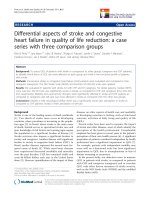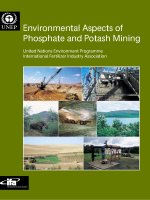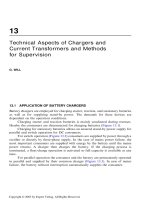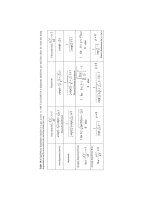Aspects of the ecology of fruit bat (eidolon helvum) in the university of energy and natural resources, sunyani
Bạn đang xem bản rút gọn của tài liệu. Xem và tải ngay bản đầy đủ của tài liệu tại đây (2.04 MB, 101 trang )
KWAME NKRUMAH UNIVERSITY OF SCIENCE AND TECHNOLOGY KUMASI
COLLEGE OF AGRICULTURE AND NATURAL RESOURCES
FACULTY OF RENEWABLE NATURAL RESOURCES
DEPARTMENT OFWILDLIFE AND RANGE MANAGEMENT
ASPECTS OF THE ECOLOGY OF FRUIT BAT (Eidolon helvum) IN THE
UNIVERSITY OF ENERGY AND NATURAL RESOURCES, SUNYANI
By
James Agyei-Ohemeng
Post Graduate Diploma
March, 2015
i
ASPECTS OF THE ECOLOGY OF FRUIT BAT (Eidolon helvum) IN THE
UNIVERSITY OF ENERGY AND NATURAL RESOURCES, SUNYANI
A THESIS
SUBMITTED TO THE SCHOOL OF GRADUATE STUDIES,
KWAME NKRUMAH UNIVERSITY OF SCIENCE AND TECHNOLOGY,
KUMASI
IN PARTIAL FULFILMENT OF THE REQUIREMENTS FOR THE
DEGREE OF MASTER OF PHILOSOPHY
IN
WILDLIFE AND RANGE MANAGEMENT
By
James Agyei-Ohemeng
Post Graduate Diploma
March, 2015
i
DECLARATION
I declare that this thesis entitled “ASPECTS OF THE ECOLOGY OF FRUIT BAT
(Eidolon helvum) IN THE UNIVERSITY OF ENERGY AND NATURAL RESOURCES,
SUNYANI” is the results of my own original work and that no part of it has been presented
for another degree in this University or elsewhere.
James Agyei-Ohemeng
………………………..
(Student No: 20348604)
Signature
…………………
Date
Certified by:
Dr. Emmanuel Danquah
………………………..
(Academic Supervisor)
Signature
Dr. Emmanuel Danquah
………………………..
(Head of Department)
Signature
ii
…………………
Date
…………………
Date
ABSTRACT
Aspects of the ecology of straw coloured fruit bats (Eidolon helvum), including population
dynamics, seed dispersal and effect on the roosting trees, were investigated in the
University of Energy and Natural Resources, Sunyani from January 2013 to July 2014. The
Continuous Point Count Method was used to estimate the monthly population size of E.
helvum. Using 64m2 (4m x 4m) quadrats and 32 seed traps made from plastic sheets, the
contribution of dispersed plant species to the total undergrowth plant cover in the area was
sampled and catalogued to show the contribution of undergrowth from bat droppings in the
area. Using six (20m x 20m) sample plots each for areas occupied by bats and areas
unoccupied by bats, basal area, canopy, and heights of identified trees with DBH ≤ 1m
were measured to show the impact of bats on the roosting trees. The results indicated that:
(1) bats were present in the study area throughout the survey period, however, their
numbers varied between months. The bat population estimates in 2013 were high in March
(180,000) and December (240,000), but between the months of May to October their
population were low, (12,400; 15990; 12,500; 18,500; 10,600 and 28,500) respectively, in
the colony. This pattern is similar to the year 2014. The mean number of bats per month
was estimated at 55,469.55 bats (S.E=4.34, CV=8.68%) for the study period. The mean
population estimates in the dry season count was 85,955.5±87,272.3 whilst the mean
population estimate in the rainy season count was 46,932.3±58,122.9. However, there was
no significant difference between the mean dry and rainy season population count of bat in
the study area, t(8) = -0.922, p>0.05(2) Undergrowth plant species sampled indicated that
the percentage contribution of some of the species dispersed by bats were Mallotus
opposotifolia,(16.1%), Broussonetia papyrifera (10.6%), Ficus exasperata (6.6%),
iii
Solanum erianthum (6.2%) and Morus mesozygia (4.6%). These plant species altogether
contributed 1.7% of the seedling composition in the undergrowth in the study area. These
plants contributed to the ecological improvement by increasing the biodiversity in the study
area through increased species cover and regeneration of dispersed species of the roost
site.(3) Height and basal area of trees were the only factors that led to tree selection as roost
by bats in the occupied zone. Trees in bat occupied areas, showed significant damages by
bats through premature defoliation as well as loss of branches which resulted in reductions
in canopy foliage of host trees, compared to the bat unoccupied areas. The main physical
plant features that were affected are the tree canopy size and canopy cover. These bats have
been known to have limited roost sites, so good management of their population to reduce
threat to their survival is important. Sound strategies like monitoring population, roosting
trees and habitat, in relation to the climatic conditions are required to be documented
overtime to promote sound decisions and add to scientific knowledge to the study of bats.
iv
DEDICATION
This Thesis is dedicated to Joyce, Ivy, Mordecai and Emmanuel Ohemeng
v
ACKNOWLEDGEMENT
This work would not have materialized without the support of my supervisor Dr.
Emmanuel Danquah, his patience and good humor during the whole work is really
appreciated. I also wish to acknowledge the support provided by Dominic Appiah and
Sraku Shadrack, students of Kwame Nkrumah University of Science and Technology,
Faculty of Forest Resources Technology, for their invaluable help during the monthly
counts. The competent and active support of Mr. Schroeder, the Technician of the
University of Energy and Natural Resources during the plant species identification was
exemplary and much appreciated.
Finally special thanks go to Mr. Abebrese, the Dean of the School of Natural Resources for
his guidance during the write up. It is my desire that this document will accurately reflect
the many ideas and suggestions they all contributed.
vi
TABLE OF CONTENTS
DECLARATION .....................................................................................................................II
ABSTRACT .......................................................................................................................... III
DEDICATION ........................................................................................................................ V
ACKNOWLEDGEMENT ..................................................................................................... VI
TABLE OF CONTENTS ..................................................................................................... VII
LIST OF TABLES ................................................................................................................. IX
LIST OF FIGURES ............................................................................................................... IX
ACRONYMS ......................................................................................................................... XI
CHAPTER ONE ...................................................................................................................... 1
1.0 INTRODUCTION ............................................................................................................. 1
1:1 BACKGROUND GAPS ....................................................................................................... 1
1.2 PROBLEM STATEMENT .................................................................................................... 5
1.3 GOAL AND OBJECTIVES ................................................................................................... 7
CHAPTER TWO ..................................................................................................................... 8
2.0 LITERATURE REVIEW .................................................................................................. 8
2.1 IMPORTANCE OF EIDOLON HELVUM ................................................................................ 8
2.1.1 THE ROLE OF BATS IN ENHANCING PLANT DEVELOPMENT ............................................ 8
2.1.2 CHALLENGES INVOLVED IN BAT POPULATION MONITORING ....................................... 10
2.1.3 FACTORS AFFECTING BAT POPULATION...................................................................... 13
2.1.4 FRUGIVORE AND IMPORTANCE OF FRUIT BATS AS SEED DISPERSAL AGENTS ............ 16
2.1.5 BATS AS SEED DISPERSAL AGENTS ............................................................................ 19
2.1.6 IMPACT OF FRUIT BATS ON ROOST TREES .................................................................. 25
CHAPTER THREE ............................................................................................................... 28
3.0 MATERIALS AND METHODS .................................................................................... 28
3.1 STUDY AREA ................................................................................................................. 28
vii
3.1.1 LOCATION .................................................................................................................. 29
3.1.2 BIOPHYSICAL SETTING ............................................................................................... 30
3.1.3 THE ENVIRONS OF UENR .......................................................................................... 31
3.2 DESCRIPTION OF THE STUDY SPECIES AND POPULATION ............................................... 32
3.3 EXPERIMENTAL PROCEDURE ......................................................................................... 33
3.4 DATA ANALYSIS ........................................................................................................... 35
CHAPTER FOUR ................................................................................................................. 37
4.0 RESULTS ........................................................................................................................ 37
4.1 POPULATION SIZE OF BATS IN UENR ............................................................................ 37
4.2 PLANTS EATEN AND DISPERSED BY E. HELVUM IN THE STUDY AREA ............................. 40
4.2.1 A LIST OF FOOD PLANTS EATEN BY STRAW-COLORED FRUIT BATS IN UENR .............. 40
4.3 IMPACT OF E. HELVUM ON ROOST TREES IN UENR ....................................................... 47
CHAPTER FIVE ................................................................................................................... 56
5.0 DISCUSSION .................................................................................................................. 56
5.1 FLUCTUATIONS IN POPULATION SIZE ............................................................................ 56
5.2 FRUGIVORY AND DISPERSAL ......................................................................................... 58
5.3 IMPACT ON TREES .......................................................................................................... 59
CHAPTER SIX ...................................................................................................................... 63
6.0 CONCLUSION AND RECOMMENDATIONS ............................................................ 63
6.1 CONCLUSION ................................................................................................................. 63
6.2 RECOMMENDATIONS ..................................................................................................... 64
REFERENCES ...................................................................................................................... 65
PLATES ................................................................................................................................. 84
APPENDIX............................................................................................................................ 88
viii
LIST OF FIGURES
Figure 1: Map of Study Area ................................................................................................. 29
Figure2: Time series Plot of Bat Population from January 2013 to July 2014...................... 39
Figure 3: Histogram of relative abundance of seedlings in the study area ............................ 46
Figure 4: Graph showing the distribution of bat counts per point and tree distribution ........ 54
ix
LIST OF TABLES
Table 1: Monthly bat estimate counts in the study area ........................................................ 38
Table 2a: Paired Sample Statistics ......................................................................................... 40
Table 2b: Paired sample Test (t) ............................................................................................ 40
Table 3a: Plants Eaten by bats in the study area .................................................................... 42
Table3b: Monthly number (percent) of fruits eaten by bats in the study area ....................... 43
Table 4: Monthly number (percent) of fruits eaten by bats in the study area ........................ 44
Table 5a:Paired Samples Statistics ........................................................................................ 46
Table 5b : Paired Samples Test ............................................................................................. 47
Table 6:Number of trees and species diversity for bat occupied and unoccupied zones ...... 48
Table 7: Mean tree basal area estimates for bat occupied and unoccupied zones ................. 49
Table 8: Mean tree height estimates for bat occupied and unoccupied zones ....................... 51
Table 9: Mean tree canopy cover estimates for bat occupied and unoccupied zones ........... 52
Table 10: Descriptive observations of some trees damaged and type of damage in the study
............................................................................................................................................... 62
`
x
LIST OF PLATES
Plate 1: E. helvum1-10 or more clusters on tree branches in the Sanctuary ......................... 84
Plate 2a: Seed trap under the canopy ..................................................................................... 84
Plate 3: Cluster sizes of bats on the same tree on different months during the study ........... 84
Plate 4: Different cluster sizes of E. helvum on different trees ............................................. 85
Plate 5: E. helvum suppressing leafing, flowering on a Newbouldia laevis in the colony .... 85
Plate 6: Tree fall, debarking, suppression of leaf formation and flowering on Tectona ....... 85
Plate 7: Ceiba pentandra at different stages of bat occupation during the study period a.
December and b. February respectively ................................................................................ 86
Plate 8: Tectona grandis in the roosting site ......................................................................... 86
Plate 9: Deloniix regia branches breaking in the roosting site .............................................. 86
Plate 10: Branch breaking of Deloniix regia in the roosting site .......................................... 87
Plate 11: Debarked stem of Deloniix regia with bats in the roosting site ............................. 87
Plate 12: Newbouldia laevis trees defoliated during bat roosting.......................................... 87
xi
ACRONYMS
BCA-
Bat Conservation Africa
BCI-
Bat Conservation International
CITES-
Convention of International Trade on Endangered Species
CV-
Coefficient of Variation
DBH-
Diameter at Breast Height
DDT-
dichlorodiphenyltrichloroethane
IUCN-
International Union of Conservation of Nature
SE-
Standard Error
UENR-
University of Energy and Natural Resources
USA-
United States of America
xii
CHAPTER ONE
1.0 Introduction
1:1 Background Gaps
The straw-colored fruit bat, Eidolon helvum (Kerr, 1792), is a Frugivorous animal in the
order Megachiroptera (Okon, 1974). Although traditionally not viewed as a charismatic
species, bats are an invaluable natural resource. Except for the most extreme desert and
Polar Regions, bats live in almost every habitat worldwide, just as they have for more than
50 million years. Nearly 1,000 different kinds of bats are known today, fully one-quarter of
known mammal species. Despite their diversity, the world’s only flying mammals remain
among the least understood of animals (Vivian, 2007).
Centuries of myth and superstition have made bats among the world’s least appreciated
wildlife. Decades of unwarranted human fear, misinformation, and persecution of bats at
their roosts have pressed populations into severe decline nearly everywhere in the world
and endangered many species (BCI, 1989). While for some species of bats it may already
be too late, sound management practices can potentially save others.
Besides the moral, ethical, and aesthetic justification for the conservation of bats, these
species are ecologically and economically important. They are among nature’s most
beneficial animals, and undoubtedly, many are keystone species (BCI, 1989). Without
them, thousands of other animal species, like mosquitoes would be abundant and spread
diseases. Plant species, like Milicia excelsa, which is predominantly dispersed by bats,
could die out, threatening entire ecosystems like rainforests.
1
Numerous factors have contributed to the decline of bats populations. The primary known
causes are the direct and indirect actions of humans (Funmilayo, 1978). The whole world is
changing at an unprecedented rate – habitat destruction, through the directly daily changing
the face of our landscape and indirectly through climate change, are the biggest threats to
wildlife conservation and for that matter bats.
Destruction of natural habitats and foraging areas also are responsible for decimating entire
bat colonies, especially if the bat population has strong site fidelity (Tuttle, 1976). In
addition, some bats have highly specific roosting requirements in terms of temperature,
proximity to foraging areas, location and type of cave. For instance, it is believed that the
endangered gray bat, Plecotus austriacus, has the most narrowly restricted cave habitat
requirements of any U.S. mammals (Hall and Wilson, 1966; Barbour and Davis, 1969;
Tuttle, 1976). Therefore, the unavailability of such roosting sites can decimate entire
populations. Harvesting of roost trees, especially in areas where uncontrolled and illegal
logging is rampant has also been responsible for declining populations. The bulk of rural
African protein from meat comes from wild animals, ranging from rats, squirrels, monkeys,
antelopes and also birds and bats, Funmilayo, (1978).
The straw-colored fruit bat, Eidolon helvum, inhabits forest and savannah, and is found up
to an elevation of 2000 m in the Ruwenzori Mountains (Kingdon, 1974). It is gregarious
and prefers to roost in tall trees by day, but has also been found in lofts and in caves in
rocks (Nowak, 1991). In Nigeria, they select trees of particular species for roosting (Okon,
1974) and some tree species, even though common, are not used. Common trees for roosts
include Eucalyptus saligna (Myrtaceae), Cocos nucifera (Palmae), Elaeis guineensis
(Palmae), and three species of Ficus (Moraceae) (Jones, 1972).
2
Bats prefer dead trees that have bare branches; if living trees are used, the leaves are soon
broken and the branches become bare. Trees used as day roosts are large with spreading
branches, commonly found in dense groves with thick undercover. At night, roosts are
chosen according to food availability. Trees are of various heights and sizes, some in
groups, others widespread (Okon, 1974). Colonies can number up to one million; in
sleeping groups of about one hundred (Nowak, 1991). Roosting clusters are located 6-20 m
above ground on sturdy branches (Jones, 1972).
During periods of migration, colonies disperse into small groups and form temporary roosts
from which they eventually form ‘regular’ roosts (Mutere, 1980). Baranga and Kiregyera
(1982) reported a colony of 70,388 bats in Uganda. According to the same authors, the
average number of bats per tree was 310; the average number of clusters per branch was 4;
and the average cluster size 8.
Most colonies use the same roosts for many years, but because of local fluctuations in food,
some colonies make regular seasonal migrations returning after a few months to their
former roosting sites (Happold, 1987). In the Ivory Coast, it has been observed to migrate,
from the tropical forest zone where it stays between June and December, to the Niger basin
in the interior where it appears in January and stays until May (Happold, 1987).
In West Africa, there are over 120 species of fruits and nectar eating bats, however, in
Ghana there are about fifteen (15) fruit eating bats, (Kankam and Oduro, 2009), feeding on
a wide range of trees in the forest landscape. They feed on leaves, flowers, and large
proportion on fruits of different families of tropical forest plant species. E. helvum is known
to feed on the following fruits, both cultivated and wild, (Musaceae) Musa sapientum,
3
(Caricaceae) Carica papaya,(Anacardiaceae) Mangifera indica, (Bignoniaceae) Kigelia
aethiopica (Combretaceae) Terminalia sp (Fujita and Tuttle, 1991). In Nigeria, E. helvum,
feeds almost exclusively at night, visiting only trees that have food resources, whereas trees
visited during the day are only for roosting (Okon, 1974). At night, small groups of bats fly
to foraging areas in straight lines. On many occasions, foraging area is not known, but the
powerful flight suggests that these bats utilize food sources many kilometers from their
roosts (Happold, 1987). Nowak (1991) suggested that foraging range may be at least 30 km
for some of the larger colonies. They may assist in the pollination of the flowers of some
trees (Ayoade, 1989), but probably not to the same extent as some of the smaller fruit bats
(Happold, 1987). Vast quantities of fruits must be required to sustain large colonies; the
daily foraging flights, and local seasonal migrations, are clearly related to the availability
and abundance of food, the fruiting times of different tree species, and the size of the
colony. Colonies do not appear to break up into smaller sub-colonies in times of food
shortage, although individuals scatter and forage in smaller groups each night. The
gregarious habits of these bats probably evolved in conjunction with their ability to forage
on many types of food resource; obviously they feed on only one or two food items that
could not be sustained in large numbers in one place for more than a short time (Happold,
1987).
Although predation is infrequent and seemingly poses little threat to populations, several
animal species are known to prey on E. helium. Key predator species include (Bubo
africanus) spotted eagle-owl, (Corvus albus) crows, (Buteo buteo vulpinus) steppe
buzzards, (Elanus caeruleus) black kites(Kingdon, 1974), snakes, (Paradoxurus
hermaphroditus) palm civets, (Genetta genetta) genets and (Accipiter) hawks (Funmilayo,
4
1979), (Peridicticus potto) pottos (Jones, 1972), (Hieraaetus ayesii) Ayers hawk eagle
(Wolf, 1984), and (Aquilla spilogaster) African hawk eagle (Louette, 1975). On the other
hand, Kingdon (1974) recorded E. helvum attacking (Corvus albus) a pied crow.
The straw-colored fruit bat, Eidolon helvum, is eaten in most West African countries
(Funmilayo, 1979), but the hunting method is unsustainable. These animals are taken by
catapults, snares, traps, guns, and in the case of bird’s sticky plant latex. The meat is
usually consumed at home with some occasionally sold on the local market. All these
contribute to the population decline of wildlife including bats. Kamins et al (2011) notes
that the peak season reported for hunting bats corresponds with the main dry season in
Ghana. This means the bats provide an important food source during the “lean” agricultural
season. In Brong Ahafo region, the current spate of hunting of the fruit bat for bush meat
sold at Techiman market is very disturbing (Personal observation).
This thesis consists of six chapters. Chapter One comprises the Introduction, justifications,
Problem Statement and Objectives. Chapter Two covers the available literature which
throws light on the topic. Chapter Three deals with the Materials and Methods and
constitutes a Description of the Study Area, Sampling Methods and how the Data was
analyzed. Chapter Four has to do with the Results, whilst Chapter Five covers the
Discussion, General Conclusions and Recommendations.
1.2 Problem Statement
Straw coloured fruit bat (E. helvum) is classified internationally as near-threatened due to
overhunting (IUCN, 2010). Listed under the Migratory Species Convention and on
Appendix II of CITES, it is protected under Ghana Wildlife laws and a subject of global
5
animal tracking research. However, bats in Africa are under-studied, underappreciated, and
under severe threat, despite their provision of essential ecological services across the
continent (Ayoade et al., 2012).
There is also a general lack of information on bat conservation in Ghana and Africa as a
whole, limited expertise on bat conservation, and widespread absence of governmental
policies on bat conservation in the sub region. Furthermore, straw coloured fruit bat
populations are battered by loss of habitat and water resources, disturbances of crucial
roosts, and, in some areas, by bush-meat hunting. Additionally, needless fears fed by longstanding myths and misinformation greatly complicate their conservation. Despite
accounting for roughly 20% of mammals’ species on the African continent, bats
conservation and research is very limited.
In spite of ecological research into different species of fruigivores, of which bats are
represented, there is very little knowledge into the general ability of bats as seed dispersers
leading to forest regeneration.
In southeast Asia, several studies linked seed removal by a particular consumer to the fate
of deposited seeds (Hamann and Curio 1999), but the few studies that have followed seeds
and seedlings for long periods of time have been mostly conducted in the Neotropics
(Russo and Augspurger 2004; Russo 2005).
Bats (Bucerotidae) are widely regarded as important seed dispersers in tropical forests in
Africa and Asia (Kemp 2001). Their ability to swallow fruits (Leighton and Leighton 1983;
Kitamura et al., 2002) and to regurgitate or defecate viable seeds (Kinnaird 1998; Whitney
et al., 1998), large home ranges (Poonswad and Tsuji 1994; Suryadi et al., 1998; Holbrook
and Smith 2000), and gut passage times (Leighton 1982; Holbrook and Smith 2000) make
6
them ideal dispersers, especially for seeded plants because of relatively fewer alternative
dispersers (Becker and Wong 1985; Heindl and Curio 1999; Kitamura et al., 2004a, 2006).
In Ghana, Kankam et al (2000) looked into the Role of the Fruit Bat (Eidolon helvum) in
Seed Dispersal, Survival and Germination in Milicia excels. There is no documented
evidence on the population, dispersal of different seeds by bats and the effect they have on
the phenology of roosting trees.
1.3 Goal and Objectives
The goal of this study is to present an ecological impact of the presence of the bat
population on their ability to disperse seeds for natural regeneration and how they affect the
trees they roost. It is to provide us with a monitoring system to look into the ecosystem
approach to conservation.
The specific objectives of the study are to:
1. Estimate the population size of E. helvum on UENR campus in Sunyani.
2. Catalogue plants eaten and dispersed by the E. helvum colony.
3. Determine the effect of E. helvum on roost tree morphology and phenology in the colony.
The following hypotheses will be tested to assist natural resources managers in the
management of bat species on the University of Energy and Natural Resources and in
similar natural forest ecosystems:
i) E. helvum are found in the University of Energy and Natural Resources, (UENR).
ii) E. helvum contribute to the dispersal of forest tree seeds in UENR from elsewhere.
iii)
E. helvum roosting affect phenology of roosting trees.
7
CHAPTER TWO
2.0 LITERATURE REVIEW
2.1 Importance of Eidolon helvum
The straw colored fruit bat, (E. helvum), breeds in tropical forests in East and West Africa.
They move outside into the savanna region in the north and south towards the Cape
Province (Kingdon, 1984).
Changes in bat populations have ramifications for agricultural and forestry segments of the
country’s economy (because bats are consumers of farm and forest insect pests and disperse
seeds), ecosystem function, and conservation of national biological diversity. There is
therefore a need for status information on a wide range of bats, and bat population
monitoring programs on a national or other broad scale.
Studies indicate that drops in abundance of bats at their roost sites may be accounted for by
exposure to pesticides through the food chain (Clark 2001), and disturbance due to
deforestation, illegal tree felling and hunting for bushmeat (Funmilayo 1978). Because of
the lack of monitoring, however, McCracken (2003) pointed out that it is uncertain how
representative population loss at identified locations may lead to the overall loss of a larger
bat population.
2.1.1 The role of Bats in enhancing plant development
A colony of fruit Bats with a very large population is observed to have destructive impact
on roosting trees and the environment (Ritcher, 2004). Eidolon helvum feeds entirely on
flowering and fruiting trees (Wilson, 1973). Roosts sites selected during the day are in tall
8
and large trees with scattered branches (Defrees and Wilson, 1988). These fruit bats help in
pollinating and promoting out crossing in flowering plants, such as Ceiba pentandra.
It is well known among tropical ecologists that bats play important role in seed dispersal
and pollination in tropical forest succession, distribution, and community composition
(Fleming and Heithaus, 1981, Fleming, 1982). Most of these bat dispersed and pollinated
plants have great economic and cultural significance to mankind (Howe, 1986).
Over 300 plants in the old world tropics are dependent on bats for pollination and dispersal
(Bat Conservation International, 2002). The role of bats such as Eidolon helvum as major
allies in ecosystem regeneration will be greatly compromised if no steps are taken to save
their populations.
Many of these plants have traits that attract animal/bats. Some of these traits include bright
colors, characteristic odors and in some cases their position on the parent plants are
described as ‘dispersal syndrome’ (Howe, 1986). Studies have shown that there is a
synchronization of fruiting functions which minimize intra and inter-specific plant
competition for animal dispersers through resource partitioning (Fleming, 1986).
It has been argued that several factors, such as spatial distribution and temporal
unpredictable germination sites have contributed to mutualism on animal and plants for
dispersal (Howe, 1986). In some cases, Howe (1993), states that most dispersal agents may
be less reliable and fail to establish their effect as special or general agents of dispersal.
Thus it suggests that the dispersal agents do not harm seed, but remove seed from parent
trees and deliver seed to a more suitable place for germination and growth. The regularity at
which the agent visits the tree makes it a dependable agent.
9
Many bats are opportunists, switching between plants, depending on food availability
(Fleming, 1982). E. helvum are noted to completely rely on fruit, pollen or nectar (Dumont,
2003).It has been explained by Fleming (1982) and Dumont (2003) that foraging strategies
of E. helvum depends on risk of predation and distribution of fruit resources. Other factors
may include colonialism, gender and age (Heithaus, 1982). Plants whose seeds are
dispersed by bats are known to fruit seasonally (Fleming, 1982). This could influence their
seasonal migration from roost site to other places where food resources are abundant.
The study is expected to add on to the existing knowledge on the role of bats especially
Eidolon helvum in seed dispersal.
2.1.2 Challenges involved in Bat population monitoring
Populations of bats (Order Chiroptera) are difficult to monitor Westcott (2011). However,
current recognition of the importance of bats to biodiversity, their ecological and economic
value as ecosystem components, and their vulnerability to declines makes monitoring
trends in their populations a much-needed cornerstone for their future management (IUCN,
2011).
Monitoring the size and distribution of bat population is challenging. Bats differ from most
other species because they are:
i) Difficult to detect away from known roost sites,
ii) Extraordinarily mobile, with individuals change camp regularly and capable of moving
hundreds of kilometers over periods of days, while,
iii) Behaviorally distributed based on their population, which appears to respond rapidly to
changes in resource distribution with entire colony and regions being colonized or vacated
in short periods Westcott et al (2011).
10
Monitoring is increasingly seen and promoted as necessary to ensure effective management
in the face of growing anthropogenic impacts. Monitoring contributes to decision making
through the establishment of a species’ abundance, distribution and dynamics and allows
for the assessment of management needs, management approaches and their effectiveness
(Elinga 2001). Monitoring programs have provided critical information in a broad range of
contexts including conservation management (Cadiou et al., 2006), disease and invasion
monitoring (Hochachka, et al., 2000) and stock assessment (Hagen et al., 2008) and form
the basis of assessment for conservation listing under a variety of national and international
frameworks.
Although rigorous estimation procedures and replicate counts over years are largely
lacking, evidence for major declines in numbers of bats at their roosting sites over specific
period of time is obviously absent.
Bergmans (1990) indicated that, bats are a heterogeneous group of mammals and require
the application of multiple approaches to monitoring. Some species are essentially solitary
and roost cryptically in foliage, whereas others aggregate in the millions at predictable
locations. Many others occur in a range of intermediate situations. Bats are highly mobile,
predominantly nocturnal, and generally roost in inaccessible or concealed situations. Their
annual cycles can include seasonal long-distance migrations, and some species form
colonies of different size, sex, and age compositions at different times of the year. They
also are susceptible to disturbance (particularly during hibernation), which can reduce
survival, Bergmans (1990).
With the possible exception of certain small colonies in which individual bats can be
completely counted, attempts to estimate bat population trend have relied heavily on use of
11
indices at local sites (Akite, et al., 2009). The use of indices and "convenience sampling" to
estimate population size and trends in animals in general is inferior to more statistically
defensible methods and can lead to incorrect inferences (Thompson et a1., 1998, Anderson
2001).
Bat conservation efforts are well founded, and current monitoring approaches, although
provide scientifically less rigorous information than is desirable, have some merit for
conservation if applied cautiously and conservatively (Decher, 1997).
Most animal populations are in alarming decline worldwide. Like most animals, bats suffer
habitat loss through the decline and wanton destruction by humans in their habitats. E.
helvum though not endangered, (IUCN, 2000), has been noted to be very vulnerable to
habitat destruction. To manage wild populations, it is very important to monitor their
population dynamics. This can contribute to decisions when establishing the abundance,
distribution and dynamics for effective management activities (Marsh et al., 2008).
Monitoring populations of wild species have provided critical information in a broad range
conservation management (Cadiou et al.,2006). The potential for tourism or eco-tourism
and the economic benefits from conserving bat populations can certainly be the main
incentive for protecting their populations. Their nightly foraging habits, when captured are
a sight that can be regularly watched by bat lovers.
At the same time documenting the seasonal migration of tropical fruit bats is very important
because of the role they play as seed dispersers in the tropical rainforests, pollinators of
fruit crops and vectors of emerging diseases (Fleming et al., 2003; Messenger, et al., 2003).
A contributing factor in the reassessment of monitoring in recent times has been the
recognition that significant resources and opportunities can be consumed by monitoring
12









